Family : Suidae

Text © Dr. Gianni Olivo

English translation by Mario Beltramini
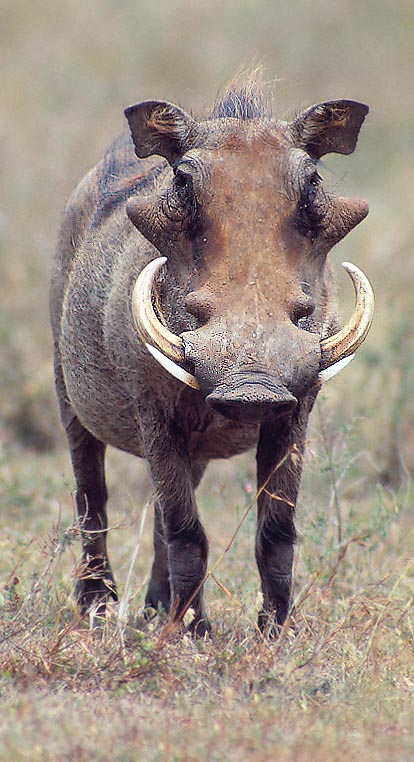
Unmistakable look of a Phacochoerus aethiopicus male © G. Mazza
The suids are non-ruminant ungulates which, in some species, have an omnivorous diet, even if, often, a preference for the vegetable substances prevails.
For instance, speaking of the African continent suids, we have, at the two ends, the Red river hog (Potamochoerus porcus) which is attracted even by carrion and remains of dead animals and which actually, sometimes, hunts small preys, insects, mammals, reptilians and batrachians, and the Giant forest hog (Hylochoerus meinertzhageni), forest swine exclusively herbivorous.
The Desert warthog (Phacochoerus aethiopicus Pallas, 1766) is, without any doubt, the African suid best known to the “great public”, not only for its unusual look and its long defences, similar to real tusks, which have made of it a star of the Disney cartoons under the name of Pumba (which, incidentally, does not mean warthog, in kiSwahili, being Ngiri or Bango the name of this animal), but also for the fact that it is the only “wild pig” essentially diurnal and which, instead of the forest, frequents the open grassy savannah.
For this reason, it is infinitely easier, for a tourist, on board a small bus painted with stripes like a zebra, to see the desert warthog, which, among other things, has a distribution range quite ample, than to see a red river hog or, even more, a giant forest hog, of nocturnal habits and which frequent zones of thick bush or forest.
In addition, indeed, the desert warthog is the most “different” among the African suids: whilst, well or bad, red river hog and giant forest hog call to mind the boar, Pumba has a so much unusual “body” and accessories (at least for the human logic) to even seem a little bit kitsch and to be noticed immediately, something like to see in a parking crowded by serious blue or black sedans, the pink Cadillac of a Texan oilman with longhorn defences on the bonnet and a raccoon tail hanging from a two-metres antenna.
Seriously, the physical characteristics of the warthog are quite peculiar: the body is more or less cylindrical, with levelled back, covered by thick and grey skin, almost glabrous, but with scattered bristles of remarkable length and with a dorsal mane which, when the animal is calm, lies on its side, but is erect when it is excited or frightened.
Long and light tufts of hairs are present also on the cheeks and on the auricles. The English name (warthog) illustrates another feature of the head of this animal, which is, in its whole, proportionally big and flattened: in the male there are two pairs of big outgrowths caused by skin thickenings, two just under and before the eyes, even 15 cm long, and other two, further ahead, on the snout, just under the emergence of the upper defences which determine, on both sides, a voluminous protrusion of the upper lip, similar to a fender. In the female, the fore “warts” are absent or are just sketched and it appears that these appendices are a defence (especially at the level of the eyes) in the fights between males and also against thorny branches, during their running between the high grasses.
The weight, in the males, varies from 70 to 105 kg, with height at the shoulder of 65-85 cm, whilst the females are smaller, with average weights varying from 50 and 65 kg and height from 55 to 70 cm. Pre-orbital odorous glands are present, as well as others placed close to the emergence of the tusks, in both sexes, but more developed and functional in the male.
There is a sexual dimorphism: the female is smaller, with smaller head and less imposing defences, furthermore, as I was saying before, the warts are two (ocular) or 7 but the fore pair vestigial or reduced. The tail is long and thin, with a terminal tuft of hairs and is kept erect when the animal is fleeing or running.
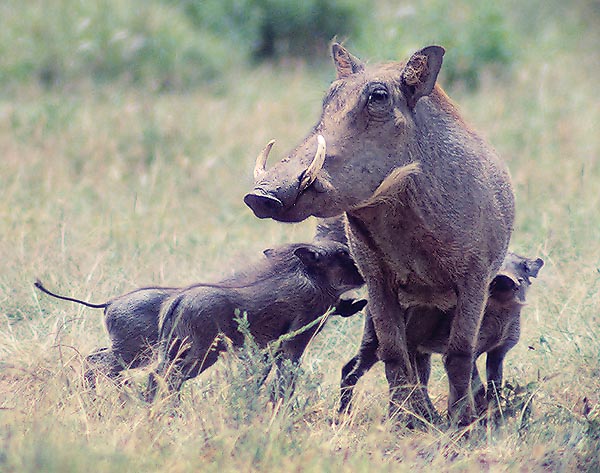
The association type is one or more females with cubs and young males or males in heat © G. Mazza
The dental apparatus is modified in relation to a chiefly herbivorous alimentation, and in fact this animal is a typical grazer that, especially in the rain season eats the grass of the savannah from the ground, or better, it is the only Africa suid being a “grazer”.
The molars and even the temporomandibular articulation are modified in function of the shredding of grasses, whilst the canines have evolved in shape of “tusks” (improper word): the upper defences, up to 60 cm long, are utilized as tools for digging (especially in the dry season, when tubers and roots partly replace the lack of nourishing grasses) and fearful defence weapons, whilst the fore defences are much shorter (10-17 cm as average) and interact with the upper “tusks” like two pairs of shears.
Typically, the upper defences are directed outwards and then curve upwards and in some instances, especially when they reach a remarkable length, the apices slightly bend inwards; the lower ones are directed towards the sides. The diet and the habitat of open savannah have determined some adaptations very characteristic and peculiar. It is frequent to see these suids grazing knelt on the forelimbs and in effect, at the level of the joint, on the fore, there is a thick and hard callosity.
This adjustment has been determined by the life in savannah and this way of nourishing is more commonly visible during the dry season and this for a precise reason: whilst in the rain season the grass is lush and represents almost the totality of the diet, in winter, or anyway when the rainfalls are poor, tubers and roots replace in good part the grass. Also the red river hog and the boar burrow (plow) the ground looking for tubers or larvae, utilizing the robust snout and the defences (the giant forest hog has lost such capacity), but the soil, in forest, wood or where the vegetation is thick, is much tender and softer than the earth cooked by the sun of the open savannah, which often becomes as hard as a brick.
For this reason, the warthog has developed a digging technique similar to that of a bulldozer. First of all, the oblique position of the body, with back limbs extended and fore ones flexed, directs the body, weight and power along a vector down and ahead, furthermore it creates a shorter and more powerful bar of a lever. This helps, with the long legs and the hard disc of the snout, in lifting and moving heavy and hard clods.
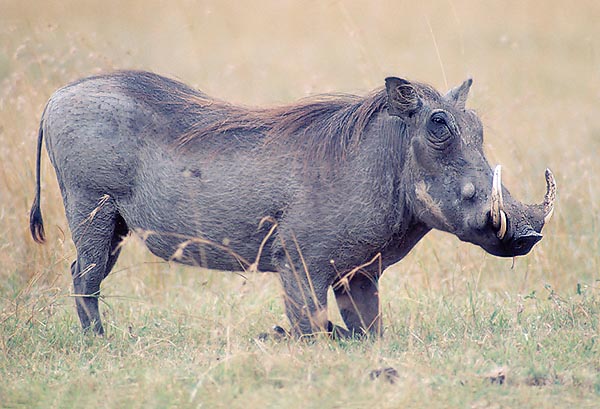
They eat knelt particularly in the dry time when the grass is low and tubers are sought © G. Mazza
Nevertheless, the young males often tend to aggregate in small groups and the elder ones often become solitary, except to unite with the small groups of females when these ones go in oestrum. Even often the groups are fairly habitual, the territory is not defended, but in case of lack of resources.
Typically, the groups are of 4-8 individuals but may count even 15 members.
Another peculiarity of the warthogs is the use of real and proper dens; usually a network of excavations and each group may utilize a ten of tunnels, some of which including a vast cavity with multiple entrances.
Anyway, for what is my own personal experience, this typology of den does not seem to be particularly appreciated, especially in zones where many predators are present. Even f the warthog may (and at times it does so) dig by itself the own den, in most of cases, in zones where the Aardvark (Orycteropus afer), is present, the dens abandoned by this burrowing animal are the most utilized.
The aardvark is the most powerful and fast burrower in the animal world: in our reserve I have seen one of them starting a digging, and, ten minutes after that the animal had entered, I moved from my hiding place and went to sound, with the help of a long branch, the tunnel, and this measured already at least five metres. Its tunnels have remarkable diameter, seen the aardvark may weigh even 70 kg, and, seen the facility with which the animal burrows them and leave and the frequent displacements seeking zones rich of ants and termites, the “unrented” dens abound: the warthogs often modify them for their own utilization, widening them or digging new “rooms”, with the help of the robust defences and of the disc at the apex of the snout.
They prefer, however, a digging with a single exit, for reasons, essentially, of security: more exits mean also more entries, from which something unpleasant may come in; furthermore, a unique tunnel is easier to defend. A typical den includes a tunnel, which often makes an elbow, at times coming back and going down underground, by the end of which there is a chamber, wider, where to take shelter.
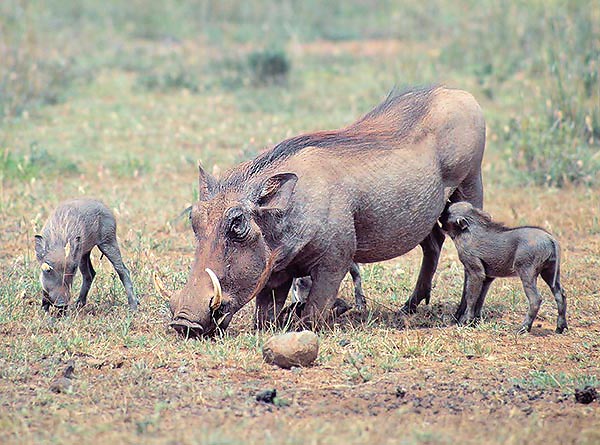
Here all eat. Kneeling is not painful thanks to a thick and hard callous © Giuseppe Mazza
Also when menaced by the approaching of a leopard, lions or hyenas, the warthog loves to enter the firs hole backwards, showing the enemy its powerful defences, without offering it an ample manoeuvring liberty or the occasion to encircle it.
In this case, even the most armed predator will have its work and even if, at the end, it will maybe succeed in extracting the prey like a snail from the shell, it will do this at the price of getting hurt.
The natural foes of this suid are many, for what the cubs are concerned, as they are often prey, also because of the frequentation of zone without coverage, also of eagles of various species. Pythons, felids of various sizes, ratels, jackals, etc. may seize the young, whilst the adult is already a more dangerous prey and its enemies are less.
The predator most interested in the warthog is the leopard, but also lions, spotted hyenas, Nile crocodiles may prevail. The cheetah usually does not dare to attack a mature warthog and also other carnivores less powerful than the previous ones. Big rock pythons may seize and eat a female and possibly also the lycaons may hunt the warthogs, even if these animals do not stay among their choice preys.
Even if less aggressive than the bushpig (in one instance, while with a friend, I was charged without apparent provocation by a big female of bushpig and I had to kill it when at a pair of metres), stopping in front of a den of aardvark requires always some caution.
A warthog sheltered there and feeling menaced often tries a sudden exit: the outcome may result in one, or both, broken legs, but in the worst hypothesis, an injury caused by the defences of this animal may be fatal, if cutting an artery (and this has already happened).
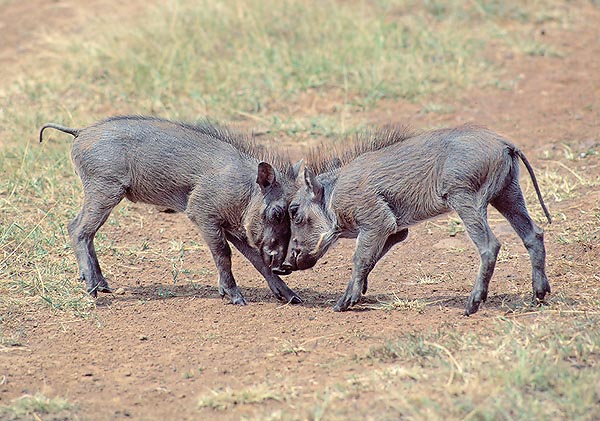
The cubs play push-push. Adults, the strong push serves to plow the soil and dig dens © Giuseppe Mazza
Being a diurnal animal is also another evolutionary adaptation to the ecologic niche occupied. The open savannah (the Afrikans word “Vlakvark” means pig of the plain), stingy of coverage and hideouts, represents a dangerous habitat often frequented by big predators, and the diurnal hours, if on one hand allow a greater visibility, on the other represent a moment of less activity of some of them, even if, obviously, lions and leopards may hunt also by daytime. If Pumba would like to would be devoted to graze by night time, it would have very little chances of survival, also because its eyesight is not very sharp.
The Phacochoerus aethiopicus has a clear reproductive seasonality, even if the periods greatly vary depending on the geographic location. Its distribution is very vast, as it includes all Africa south of Sahara, excluding only the central-African forest, the coasts of the Gulf of Guinea and the most arid zones of southern Africa, therefore the season of the births changes in function of the rain season. Usually, in fact, the period of the “heat” coincides with the end of the rains or with the beginning of the dry season, whilst the births happen by the beginning of the following rain season, as the gestation lasts about 160 days; the female delivers an average of 2 or 3 newborn, even if in some cases the farrow may reach the 8.
To conclude, therefore, in a little more light way and to render less arid the description, I would say that Phacochoerus aethiopicus represents a “custom” model of wild pig, modified and adapted, with various accessories, to an environment not typical to the one coming to mind when talking of “boars”, a pioneer which, perhaps for avoiding the competition, has ventured and adapted to an habitat which is averse to the various cousins of wood and forest.
Common names: English:Warthog; Spanish: Facocéro; French: Phacochère; German: Warzenschwein; Afrikaans: Vlakvark; Zulu: Indlovudwana-Ingulbe yemlimi; Ndebele: Ingulube; Shangaan: Ngulube; Venda: Phangwa; Tswana: Kolobe; Siswati: Budzayikatana; Sotho: Kolobe; Lozi: Kolobe; Yei: Ungili; Swahili – Ngiri , Bango; Somali: Dufar, Carcari; Arabic: Halluf; Haussa: Darunga, Diado; Guinean: Ghiro-o; Cameroonese: Gaduru; Banda: Vumba; oshiVambo: oShingulu; otjiHerero: oMbinda; seSotho : Kolobe, Kolobe moru, Mokgesi.
→ For general information about ARTIODACTYLA please click here.
